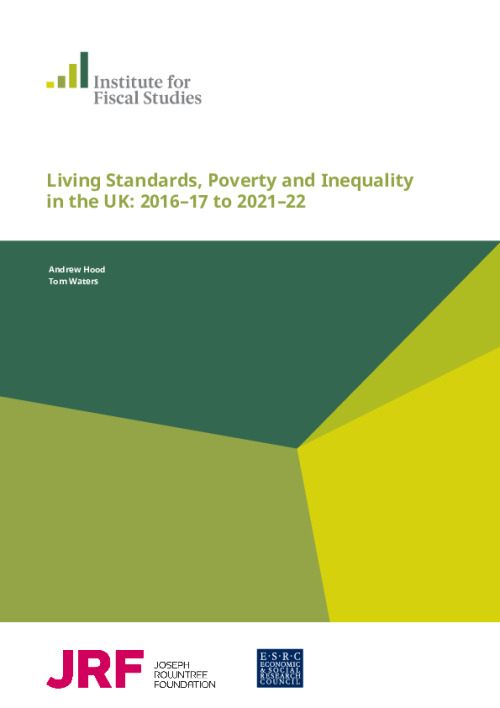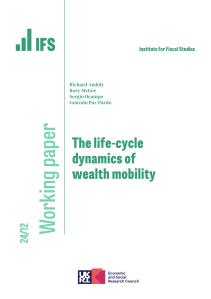Debates over living standards, poverty and inequality in the UK are often hampered by the fact that official data on household incomes are available only with a significant lag. Currently, the latest statistics are for 2014–15. In this report, we attempt to fill this gap by estimating what has happened to household incomes between 2014–15 and 2016–17 based on other data sources and changes to direct tax and benefit policy.
We estimate how the incomes of different households would evolve up to 2021–22 if current tax and benefit policy plans are kept to and if the macroeconomic forecasts from the Office for Budget Responsibility (OBR) – for things such as earnings and employment – were correct. We also consider macroeconomic scenarios that are more and less optimistic than the OBR’s central forecast.
Key findings
| Real median income is projected to grow by 3.8% between 2016–17 and 2021–22, but this projection is highly sensitive to future pay growth. | If workers’ earnings grow in line with the OBR’s forecast, we project that real median income growth will be close to zero over the next two years, before picking up after 2018–19. If average earnings grow 1 percentage point (ppt) per year faster or slower than the OBR expects, our projections for real median income growth between 2016–17 and 2021–22 are 6.8% and 1.0% respectively. | |
| If earnings grow in line with the OBR forecast, we project median income in 2021–22 will be only 10% higher than it was in 2007–08. | This is very slow growth by historical standards. Average income in 2021–22 is projected to be more than 15% lower than if income growth since 2007–08 had been in line with the long-run trend (equivalent to more than £5,000 a year for a couple without children). | |
| We project that median income will continue to rise more quickly for pensioners than for the rest of the population. | If earnings grow in line with the OBR’s forecast, we project that median income for pensioners will grow by 6.8% between 2016–17 and 2021–22, compared with just 3.3% for non-pensioners. After housing costs have been deducted (AHC), median pensioner income is projected to be 7.7% higher than median income for the rest of population by 2021–22, having been nearly 10% lower in 2007–08. | |
| We project an increase in income inequality over the coming years, particularly if incomes are measured after housing costs have been deducted. | The main reason is that real earnings growth tends to benefit high-income households more than low-income households. But planned cuts to working-age benefits also act to increase inequality: higher forecast inflation means that the benefit freeze is now expected to reduce the value of those benefits by 6%, and housing benefit will often no longer cover rent increases faced by low-income private renters. In fact, real AHC incomes are projected to fall between 2014–15 and 2021–22 for the poorest 15% of households on average. | |
| As a result, the official rate of relative AHC poverty is projected to rise by 2.3ppts from 21.3% in 2014–15 to 23.6% in 2021–22. | The direct impact of tax and benefit reforms over this parliament explains about one-third of this projected increase, as cuts to working-age benefits primarily affect low-income households. But most of the increase is again explained by earnings growth benefiting middle-income households more than lower-income ones. | |
| The official rate of absolute AHC poverty is projected to fall slightly, from 20.3% to 19.8% between 2014–15 and 2021–22. | In the absence of tax and benefit changes, we would project a 1.1ppt fall in absolute AHC poverty (to 19.2%), but once these changes are incorporated the expected decline is roughly halved. Between 2007–08 and 2021–22, we project a 2.3ppt fall in absolute poverty – over the previous 14 years, it fell by 19ppts. | |
| But we project that absolute AHC child poverty will rise from 27.5% in 2014–15 to 30.3% in 2021–22. | This increase is entirely explained by the impact of tax and benefit reforms over this parliament. On the other hand, we project falls in absolute AHC poverty rates among pensioners (from 12.8% to 10.9%) and working-age adults without children (from 17.6% to 15.6%). | |
| Cuts to universal credit work allowances explain around a third of the increase in the absolute AHC poverty rate for children in working households. | Work allowances in universal credit – the amount a claimant can earn before their benefits start to be withdrawn – were cut in the 2015 Summer Budget. This £3 billion takeaway from low-income working households increases projected absolute AHC poverty among children in working households in 2021–22 from 22.6% to 23.3%, compared with a 2014–15 level of 21.2%. The cut to the taper rate announced in the 2016 Autumn Statement provided only partial compensation. |










